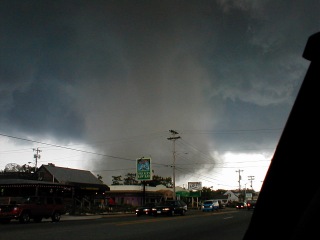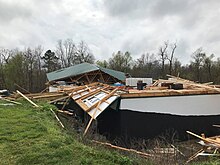The Tornadoes Portal

Selected tornado article -
The Storm Prediction Center (SPC) is a US government agency that is part of the National Centers for Environmental Prediction (NCEP), operating under the control of the National Weather Service (NWS), which in turn is part of the National Oceanic and Atmospheric Administration (NOAA) of the United States Department of Commerce (DoC).
Headquartered at the National Weather Center in Norman, Oklahoma, the Storm Prediction Center is tasked with forecasting the risk of severe thunderstorms and tornadoes in the contiguous United States. It issues convective outlooks, mesoscale discussions, and watches as a part of this process. Convective outlooks are issued for the following eight days (issued separately for Day 1, Day 2, Day 3, and Days 4–8), and detail the risk of severe thunderstorms and tornadoes during the given forecast period, although tornado, hail and wind details are only available for Days 1 and 2. Day 3, as well as 4–8 use a probabilistic scale, determining the probability for a severe weather event in percentage categories (15%/yellow and 30%/orange). (Full article...)Selected tornado list -

Selected image -

Selected tornado year -
Related portals
2024 tornado activity
Tornado anniversaries
June 16
- 1942 – A tornado struck southern Brazil, destroying many buildings including two hotels and a church. Reports from the day after indicate that more than 20 people were killed and hundreds were injured.
- 1992 – An F5 tornado moved through Chandler, Minnesota, destroying 75 homes and damaging more than 90 other structures. One person was killed and 40 were injured.
- 2014 – A strong supercell spawned a complex family of six tornadoes in northeastern Nebraska, four of which were rated EF4. The most destructive of these destroyed about half of Pilger and killed one person. A simultaneous EF4 tornado east of the town killed another person. Video of these twin tornadoes was widely shown in news media and online.
June 17
- 1944 – A significant tornado outbreak affected the Upper Midwest. An F5 tornado obliterated farms near Wilmot, South Dakota, killing eight people. An F4 tornado destroyed more farms near Henry and Florence, South Dakota and passed through Long Lake, killing three people. An F3 tornado destroyed 20 buildings and unroofed a school in Bath, South Dakota, leaving two dead. The tornadoes from this outbreak are only listed as windstorms in official records, even though well-defined funnels were spotted.
- 1946 – An F4 tornado touched down in Melvindale, Michigan and crossed the Detroit River, killing at least 15 people as it moved through Windsor and Tecumseh, Ontario.
- 1978 – An F1 tornado moved across Pomona Lake in Osage County, Kansas and capsized the tour boat Whippoorwill, drowning 16 of the 58 people on board and injuring 3 others. This was the deadliest tornado on record to receive a "weak" (F0 or F1) rating on the Fujita scale.
June 18
- 1939 – An F4 tornado moved through the Minneapolis–Saint Paul area, destroying 40 homes in Anoka, Maple Grove, and Champlin, killing nine people and injuring 222. Some homes were swept away. Four people died in a car that was thrown 300 yards.
- 2001 – An F3 tornado damaged or destroyed 240 buildings in Siren, Wisconsin, killing two people and inuring 16.
Did you know…
- ...that the 2013 Moore tornado that struck Moore and Newcastle, Oklahoma, is the most recent EF5 tornado?
- ...that the 2021 South Moravia tornado, an IF4 tornado with winds between 207–260 mph (333–418 km/h), was the strongest tornado to hit the Czech Republic in modern history?
General images -
Accompanying Hurricane Katrina's catastrophic coastal impacts was a moderate tornado outbreak spawned by the cyclone's outer bands. The event spanned August 26–31, 2005, with 57 tornadoes touching down across 8 states. One person died and numerous communities suffered damage of varying degrees from central Mississippi to Pennsylvania, with Georgia sustaining record monetary damage for the month of August. Due to extreme devastation in coastal areas of Louisiana and Mississippi, multiple tornadoes may have been overlooked—overshadowed by the effects of storm surge and large-scale wind—and thus the full extent of the hurricane's tornado outbreak is uncertain. Furthermore, an indeterminate number of waterspouts likely formed throughout the life cycle of Hurricane Katrina.
The outbreak began with an isolated F2 over the Florida Keys on August 26; no tornadoes were recorded the following day as the storm traversed the Gulf of Mexico. Four weak tornadoes were observed on August 28 as the hurricane approached land, each causing little damage. Coincident with Katrina's landfall, activity began in earnest on August 29 with numerous tornadoes touching down across Gulf Coast states. Georgia suffered the greatest impact on this day, with multiple F1 and F2 tornadoes causing significant damage; one person died in Carroll County, marking the first known instance of a tornado-related death in the state during August. A record 18 tornadoes touched down across Georgia on August 29, far exceeding the previous daily record of just 2 tornadoes for the month throughout the state. Activity diminished over the subsequent two days as the former hurricane moved northward. Several more tornadoes touched down across the Mid-Atlantic states before the cessation of the outbreak just after midnight local time on August 31. (Full article...)List of Featured articles and lists
|
|---|
Topics
Subcategories
Related WikiProjects
The scope of WikiProject Severe weather is to write articles about severe weather, namely thunderstorms and tornadoes. Their talk page is located here.
WikiProject Weather is the main hub for all articles that are weather-related. WikiProject Weather strives to improve articles in a variety of weather topics, including Tropical Cyclones, Severe Weather, General meteorology, Non-tropical Storms, Climate, Floods, Droughts and wildfires, Meteorological instruments and data, Meteorological Biographies, and Space Weather. If you would like to help, please visit the project talk page.
WikiProject Meteorology is a collaborative effort by dozens of Wikipedians to improve the quality of meteorology- and weather-related articles. If you would like to help, visit the project talk page, and see what needs doing. The project is currently being merged into WikiProject Weather.
WikiProject Tropical cyclones is a daughter project of WikiProject meteorology. The dozens of semi-active members and several full-time members focus on improving Wikipedia's coverage of tropical cyclones.
Wikipedia is a fully collaborative effort by volunteers. So if you see something you think you can improve, be bold and get to editing! We appreciate any help you can provide!
Things you can do
Wikimedia
The following Wikimedia Foundation sister projects provide more on this subject:
-
Commons
Free media repository -
Wikibooks
Free textbooks and manuals -
Wikidata
Free knowledge base -
Wikinews
Free-content news -
Wikiquote
Collection of quotations -
Wikisource
Free-content library -
Wikiversity
Free learning tools -
Wikivoyage
Free travel guide -
Wiktionary
Dictionary and thesaurus









































